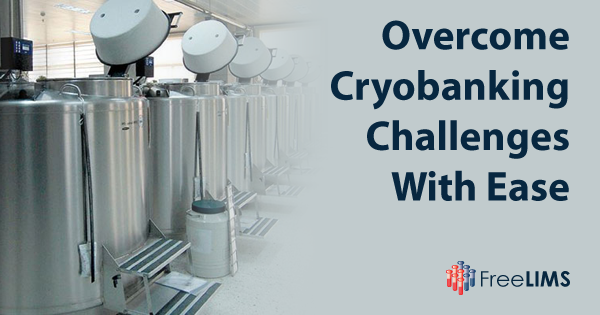What is Cryobanking?
Cryobanking, also known as cryopreservation, is the process of freezing cells, tissues, and biological samples at very low temperatures. Cryobanks store samples at temperatures as low as –80 °C using solid CO2 or −196 °C using liquid nitrogen. This helps preserve the structural integrity and functions of the samples for an indefinite period. Cryobanking is essential for the healthcare industry as it helps store samples for years for scientific and medical use.
Benefits of Cryobanking
- Enables the discovery, storage, and study of biological samples
- Prevents cross-contamination of samples
- Safeguards sample integrity and viability
- Allows sample preservation for long periods
- Reduces sample heterogeneity which is usually introduced in passaging (i.e. splitting cells to generate more cells)
Steps Involved in the Cryobanking Process
The primary step in cryobanking involves mixing cryoprotectant agents (CPAs), such as dimethyl sulfoxide (DMSO), glycerol, and propylene glycol with biological samples before cooling. Different freezing methods are then applied to preserve compounds such as enzymes within the cells. The samples are then stored in liquid nitrogen or dry ice for at least 5 to 24 hours. The cells are then slowly warmed to let them dehydrate and prevent the damage caused due to intracellular ice, known as the thawing process. The final step includes the removal of the CPAs from the samples.
Factors to Consider for Successful Cryobanking
- Efficient Storage Solutions
It is important to store biological samples at optimum temperatures to maintain their quality and assure they are research grade and fit-for-purpose. Ultra-low temperature (ULT) freezers store samples at temperatures as low as –86 °C for an extended period. ULT Freezers help maintain sample integrity and ensure reliability and safety. Moreover, Liquid Nitrogen (LN2) freezers offer excellent storage capability for a long time and are designed in a way to eliminate the risk of cross-contamination of samples. - Appropriate Cryoprotectant Agents (CPAs)
Cryoprotectant agents are chemical compounds that prevent damage in biological samples during the freezing process. The most common types of CPAs are Dimethyl Sulfoxide (DMSO) for mammalian cells, glycerol for bacterial and red blood cells, and propylene glycol. CPAs protect samples from ice crystals. It is important to choose the right CPA and administer it at the right concentration. A highly concentrated CPA is likely to cause cytotoxicity in samples and may also deteriorate sample viability. - Rate of Freezing
Typically, biobanks freeze samples at a standard rate of -1°C/min to prevent damage. Slow cooling allows samples the time to dehydrate and prevents the formation of intracellular ice. It is essential to control the freezing rate of samples to maintain their viability even after the thawing process.
Challenges in Cryobanking
Every opportunity comes with multiple challenges. Cryobanking also has its limitations. Freezing reduces the recovery rate of samples, thus causing discrepancies in clinical applications. The formation of ice crystals damages the samples. Biobanks use CPAs and control the rate of freezing to overcome this challenge. CPAs introduce another challenge, cytotoxicity, if used in high concentrations. Biobanks should use a combination of CPAs to prevent cellular cytotoxicity.
Even though cryobanking is done to preserve samples for years, many samples get destroyed in the process, depending on their adoption to freezing. For example, T cells recover well when frozen but their functionality may get compromised, whereas granulocytes do not recover after freezing. Ex vivo tissue cultures such as organoids lose heterogeneity on freezing. RNA samples degrade in a – 80°C freezer if opened many times. Therefore, it is important to properly cryopreserve samples based on the sample or tissue type and carefully handle them.
Moving Towards Enhanced Cryobanking
Researchers have been looking for ways to enhance the cryobanking process to store the samples more efficiently. Researchers are looking for:
- Process automation to overcome the challenge of storing and preserving more numbers of samples for long periods.
- Alternatives to DMSO because it could be toxic to samples. The fetal bovine serum used with DMSO can provide protein to cells; however, it is not ideal for all samples. An ice-binding protein is a better way to increase the recovery rate of samples.
- A way to freeze the cells attached to tissue culture plates for quick use.
How Can a Biospecimen Management System Drive Cryobanking?
A biospecimen management system, also known as biobanking LIMS, helps automate cryobanking workflows, reduces the need for labor, and eliminates manual errors. A biospecimen management system helps manage freezer inventory and shipment of samples. Moreover, a biospecimen management system tracks samples using barcodes through the sample life cycle. ULT freezers need to maintain a certain temperature to store samples. They require regular maintenance to do so. A biospecimen management system can help cryobanks schedule maintenance periodically and record maintenance data for internal and external audits.
A temperature monitoring system helps monitor the temperature of freezers in real-time, thus providing more control and visibility to cryobank managers. A biospecimen management system can be integrated with IoT-powered temperature monitoring systems to centrally store temperature data of all freezers and analyze trends over a period of time. This helps cryobank managers to get alerts on temperature changes and fluctuations, enabling them to take necessary actions as and when required.
Conclusion
Cryobanking aids in the success of many medical procedures by preserving beneficial samples for years. The process has been gaining importance in many emerging areas, including cell therapy. For example, CAR-T cell therapy for treating cancer. The applications of cryobanking are likely to expand in the future, with its continuous contribution to medical research. However, successful cryobanking requires the right freezers, temperature control, and process automation. A sample management software is a perfect partner for cryobanks to enhance their operational efficiency.


